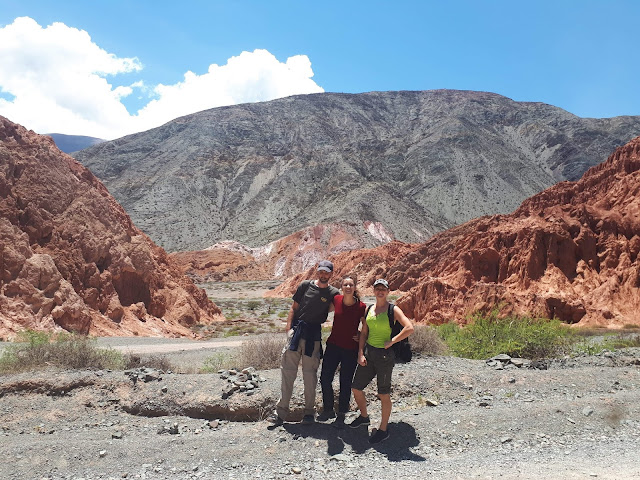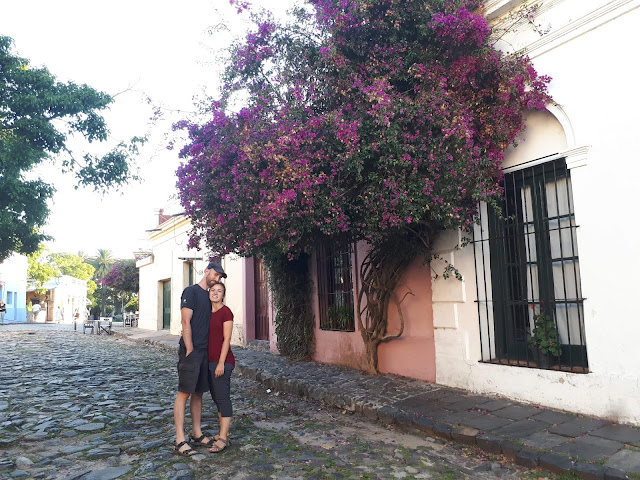Looking at a map the road south from Posadas follows the western border of Uruguay with multiple border crossings to choose from. As we were on a night bus it made some sense to stop at the furthest south crossing (more sleeping time) and make our way from there. Border crossings must have cross border traffic right?
So just after sunrise (because our bus was an hour late), we were unceremoniously dumped on the side of the highway outside the town of Gualaguaychu. We'd hoped they'd at least stop at the bus station but instead we found ourselves in the rain at a 24hr truck stop and in need of a saviour. And behold! One appeared before us in the form of a Portuguese lady that had resettled there after getting married to a local. What are the odds that we would find a foreign, English-speaking, helpful person working at a truck stop in a town that can't possibly have any foreign tourists passing through ever? And to add to the miracle, she was just getting off work and a city bus happened to pass by and pick us up to take us into the city, with her as guide, so we could find the bus station. It took 2 buses and almost an hour but it was glorious. We were saved. We were down to our last pesos too so taking a taxi probably wasn't really an option for us. Such are the quirks of travel where you really don't know what is going to happen but you have to carry on believing that you will get where you need to go in the end.
We were in for a few more surprises at the bus station. Despite being the closest road link to Uruguay from Buenos Aires, there was only 1 bus a day going across the border and we would have to wait about 4 hours to catch it. The bus station is quite small with a sitting area for maybe 40 people and a single small cafe but it was more appealing than running around lost in the rain so we sat and waited. It was also a shock to find a small tourist office in the station that was not only open (somehow a rarity everywhere we go) but was staffed by someone that spoke English! This might not seem that unusual to you but it was mind-blowing. This just has not been happening to us. I started to rethink the importance to Gualaguaychu... Maybe they have ambitions. Maybe they are the secret English-speaking hub of Argentina. Unfortunately she couldn't make buses magically appear sooner. So we waited...
With another bridge over another river doubling as a border (all the borders so far have been rivers), we entered Uruguay without issue. It was a quick and quiet crossing and we quickly found ourselves in the small town of Fray Bentos. We'd hoped to enter a lot earlier in the day and get things moving along but our arrival at 2pm put a stop to our progress.
All 0 of my British readers might recognize the name Fray Bentos as the brand name of a meat pie still sold in the UK. In 1863 a meat processing plant was opened there and for the next 116 it became the dominant industry in the region, essentially turning Fray Bentos into a wealthy industrial town. The meat processing company morphed a few times over the years but was at its peak during the "Anglo" years in the first half of the 1900's with over 5000 workers, exporting its products around the world from its own port on the Uruguay River, including being a major supplier to the armies of both world wars. The town within a town that grew up beside the industrial area included it's own hospital, recreation areas, school etc, and was also abandoned when the factories shut down for good in 1979. Now a world heritage site, it is possible to visit some of the old buildings to see them in their current state of decay. This is what we did but we arrived too late for the guided English tour which was only available that morning. It was still really interesting and incredibly atmospheric to walk through some abandoned engine rooms in pools of water listening to the drip drip drip of the last of the rainwater falling through the holes in the roof or peering through cracked and dirty windows trying to figure out which part of the processing that building was used for.
This place is not a well known tourist attraction yet and we were the only ones there but we really enjoyed it and the small attached museum. There wasn't much English so I can imagine it would have been even better with the guide, but there were lots of old photos (some quite graphic) and materials (old equipment, product cans, and the old admin offices) to give enough of an idea. In a way we felt a little too rushed to enjoy it as much as we probably would have if we'd gotten there earlier. We ended up staying the night in Fray Bentos, which is otherwise a pretty small and sleepy town now with a couple of small plazas and the odd nice building like the theatre still standing from its glory days.
 |
| Fray Bentos old offices |
 |
| Anyone recognize any of these? |
 |
| Engine room |
 |
| The old port |
 |
| Fray Bentos theatre is still in use |
 |
| One of two nice plazas |
The following morning we caught a bus to Colonia del Sacramento, originally a Portuguese settlement and one of the oldest in Uruguay. It sits across the Rio de la Plata from Buenos Aires and was a site of contention for its first 150 years, being involved in a couple sieges and changing hands between the Spanish and Portuguese a few times in that period. Today it is a small but very touristy town, popular with day trippers from Argentina as well as for those transiting between Buenos Aires and Montevideo as Colonia has a busy ferry terminal between Uruguay and Argentina.
We arrived late after our bus had to reroute because of flooding on the roads but still had enough time in the afternoon and evening to wander around the small historic centre of Colonia. It has a few tiny streets and a church or two, a plaza, the remains of some city walls and coastal fortifications and a lighthouse you can climb for a view over the area. The Rio de la Plata is quite wide here and looks much more like the sea, but is technically the wide river mouth still at this point. On a clear day you can see Buenos Aires in the distance.
 |
| Flooding on the way to Colonia |
 |
| One of the oldest streets in Colonia |
 |
| The lighthouse built on church ruins |
 |
| Climbing |
 |
| View from the top. It's a very green town. |
While Colonia was pleasant enough, in comparison to the Portuguese colonial towns in Brazil, it is smaller, far less interesting and much more expensive. In the interest of keeping things moving and saving time for elsewhere, we decided to not head any further east to Montevideo, spent the night in Colonia and caught the ferry to Buenos Aires the next morning. Our experience in Uruguay led us to believe that the country is mostly flat and dotted with small farming communities. I had no idea that its population was so small relative to its neighbours and by land area is actually smaller than Guyana. It felt quite developed and peaceful too though I'm sure Montevideo is a different beast altogether with more than half the population.
Ammon







































































